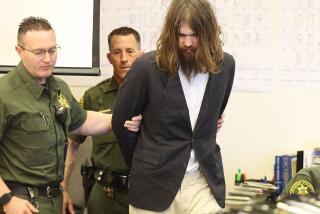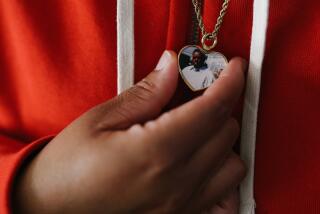Fight to the End
- Share via
“There will be a time when I need help to die. I have my criteria. When I am blind, when I am paralyzed and unable to enjoy the quality of my life, I really hope to have a quick, painless exodus.”
--Thomas Robert Edwards,
Jan. 15, 1996
*
In the end, he was blind and he was paralyzed. The pain, he said, was indescribable. As for the quality of his life, only a dying man can say whether the simple, excruciating act of staying alive has quality.
But it is clear that Thomas Robert Edwards--the only person in California with a legal right to a “peaceful, dignified, physician-assisted death”--didn’t get it. When he died earlier this spring in the small white bedroom of his West Hollywood home, it was after many months of the suffering he had gone to court to avoid.
As John Doe, the 37-year-old film editor was the plaintiff in the landmark 1995 federal lawsuit challenging California’s ban on assisted suicide. As an anonymous AIDS patient, Edwards’ role in the U.S. District Court action was to represent the interests of all terminally ill Californians.
Although retired Michigan pathologist Jack Kevorkian was Edwards’ co-plaintiff, Edwards never met the notorious “Dr. Death.” But even if he disapproved of Kevorkian’s bizarre methods, Edwards told The Times in early 1996 that he believed Kevorkian’s heart was “in the right place.”
Whatever their differences, their lawsuit was victorious. But a federal judge stayed the order overturning California’s law against assisted suicide pending a final decision in the matter before the U.S. Supreme Court. (That decision, which will affect all state bans on assisted suicide, is expected to be handed down within the next six weeks.)
Attorney Mark Field, of the Long Beach firm Lawrence Silver & Associates, recalls his very sick client’s excitement last September when told that he had won the right to a medically assisted death.
“Although he was terribly ill, Thom was still in a very positive frame of mind,” Field says. “I explained to him that even though the order was technically stayed, he had won and if he got to the point where he wanted to exercise the right to die, he should call me and I had no doubt he would be allowed to do it. But I never got that call.”
Had the call been placed and had a court order been issued, Edwards’ doctor says he would have given his dying patient “whatever he needed to kill himself.” But that doctor, infectious-disease specialist Ralph Hansen, told The Times this week that when he took over Edwards’ case from a retiring osteopath, no one told him that Edwards was John Doe.
“There were no specific directives left to me about his case, how to handle it, or that the patient had expressed a desire for an assisted suicide in the end stage,” says Hansen, a Beverly Hills internist with a busy practice treating patients with HIV and AIDS.
“I only found out that Tommy Edwards was John Doe when a reporter called and told me that,” Hansen says.
John Guard, Edwards’ partner and heir, says the dying man had, in fact, already stockpiled enough medications to give himself a fatal overdose “when the time came.” But Guard, like Edwards’ sister and others close to him in the months before his death, believes a tiny shred of hope for a cure kept Edwards from taking the pills.
And later, when all hope was gone, say those who were with him at the end, Edwards was too ill to carry out his own death. “And there was no physician in sight to help,” Guard says.
In 1995 when the John Doe lawsuit was filed, his longtime doctor, Reginald Warren, told Edwards to count him out. “It was clear to me that Dr. Warren disapproved of Thom’s part in the suit,” says Field, who added that it was only after repeated written and verbal requests that Warren released his patient’s medical records for use in court proceedings.
Medical records obtained by The Times indicate that Warren saw Edwards often, even when it meant traveling to his patient’s home to treat him. But his successor does not usually make house calls and says he had no orders from Warren to make an exception for Edwards.
When Warren retired to Florida at the end of January, Hansen took on Edwards’ case. It is a mystery, Hansen says, why he did not see or speak with Edwards for the next seven weeks. Hansen says there may have been “some tension and poor communication between my office staff and Tommy’s caretakers.”
But when he did finally learn that “pain was an issue for Tommy,” Hansen says he ordered an IV morphine drip and, days before Edwards’ death, visited him at home.
Last week, Guard filed a formal complaint with California’s Osteopathic Board of Medicine charging Warren with abandoning Edwards by not arranging for his level of care to continue after the doctor retired. Warren could not be reached for comment and his former office staff said they had no telephone number for him.
Guard also filed a formal complaint against Hansen with the Medical Board of California charging that Hansen “abandoned Thom Edwards in the months before his death.”
“Speaking for Tommy’s family, I can tell you we are stunned by what appears to be the really awful, awful months my brother suffered,” Edwards’ older sister Katie Kristoffer told The Times. “We all knew when the end was near. He was gasping for breath and finally couldn’t talk. The pain he was in, I can’t understand how this suffering was allowed to go on,” she said in a phone interview from her home in New York.
“This is especially painful when you recall that this is the very man who went to court because he didn’t want anyone--including himself--to suffer so.”
By Christmas of 1996, Edwards, once a fit 150 pounds, was an emaciated form beneath his soft chenille bedspread. His curly blond hair was falling out in clumps; what little remained was gray or white. His skin, once burnished by the sun, was now sallow and parchment dry; his blue eyes, dull and sunken.
Fevers raged through his body. His diarrhea was relentless. And despite more than a year of weekly injections into his eyeballs in hopes of saving his sight, the colors were fading fast. “I would go into his room and he would say, ‘John, turn on the lights. John, open the shades.’ And I would have to tell him, ‘The lights are on, Thom. The shades are open. It’s a beautiful sunny day.’ ”
As Thom Edwards grew sicker and sicker, and increasingly irrational, his companion became more frantic. “I called AIDS Project Los Angeles constantly,” Guard recalls. “Thom had been enrolled in their program for all sorts of services for months, but there seemed to be a hold on his file or something.” APLA officials say they are bound by patient confidentiality not to discuss specific cases, even after the client’s death.
According to Guard, Edwards was assigned a case manager and a social worker, but, Guard says, “They were invisible. . . . No. I take that back. We did hear from the case manager in the end. He called the house to see how Thom was doing--three days after Thom died.”
In mid-March, Guard wrote to Hansen demanding that he see Edwards at home and immediately order the intravenous narcotics or turn the case over to another physician. One week after Hansen came, Edwards died of complications from AIDS.
For his lover, who is himself HIV-positive, the end was long overdue. “I can tell you after seeing this, I am scared to death about what may happen to me,” Guard says.
For Hansen, Edwards’ case remains a puzzle. “From my perspective, I am very aggressive about pain management. For whatever reason the message didn’t get through to me about Edwards’ pain for several weeks.
“Although I’ve never been involved in a case where the patient had won the right to an assisted suicide, if he had the court order and I had OKs from a malpractice lawyer and in my judgment the patient was competent, I wouldn’t have a problem doing it.”
Looking back, Edwards’ sister now sees her brother as a martyr for the cause of medically assisted suicide.
“In this country we wouldn’t do this to a pet,” Kristoffer says. “Here’s a boy who loved animals so much that as a child, he wrote little love notes to his goldfish on the fishbowl at night. He cared about every living thing, but in the end nobody gave him the same courtesy.
“I know he’s in a better place now. But getting there . . . my God.”
More to Read
Sign up for Essential California
The most important California stories and recommendations in your inbox every morning.
You may occasionally receive promotional content from the Los Angeles Times.









